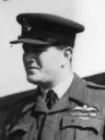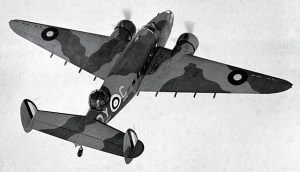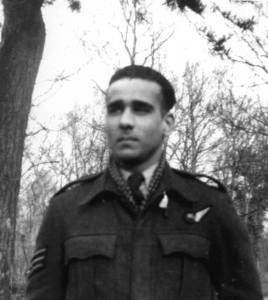161 Squadron
Operational Sorties Feb/Mar 1944
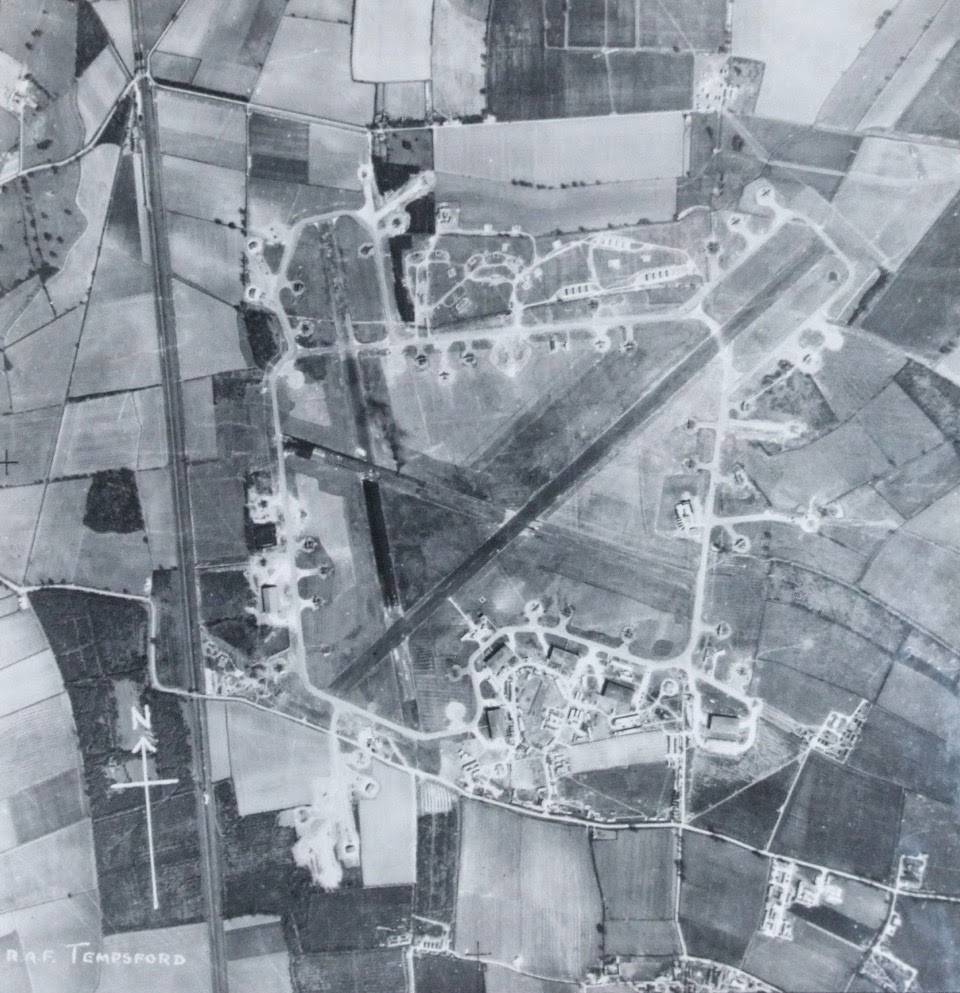
Unit 161 SD (Special Duties) Squadron RAF Tempsford –
7th February to 8th March 1944
Tempsford Airfield, actually lies within the Parish Boundaries of nearby Everton, but as the Base was accessed from Tempsford Station, the Staff & Pilots named it Tempsford Airfield, although any reference to the Airfield as RAF Tempsford is inaccurate. The Airfield became part of what was known as the ‘Bedford Triangle‘, a Secret Network for War Intelligence, the other points were made up from Harrington Airfield to the North & a Communications Site to the West, famously known as Bletchley Park Manor. Work on the Airfield started in 1940 by John Laing & Sons Ltd & the 3-Runways were completed by the Summer of 1941. The Main Runway was 6000-ft long, the other 2 being 4800-ft & 4200-ft long respectively. The Control Tower faced the Main Runway & behind this were 6 x ‘T2‘ Type Hangers, one of which now stands at Duxford Museum (Junction 10, M11). A remaining Hanger, a ‘B2‘ Type, was used by 161 Squadron.
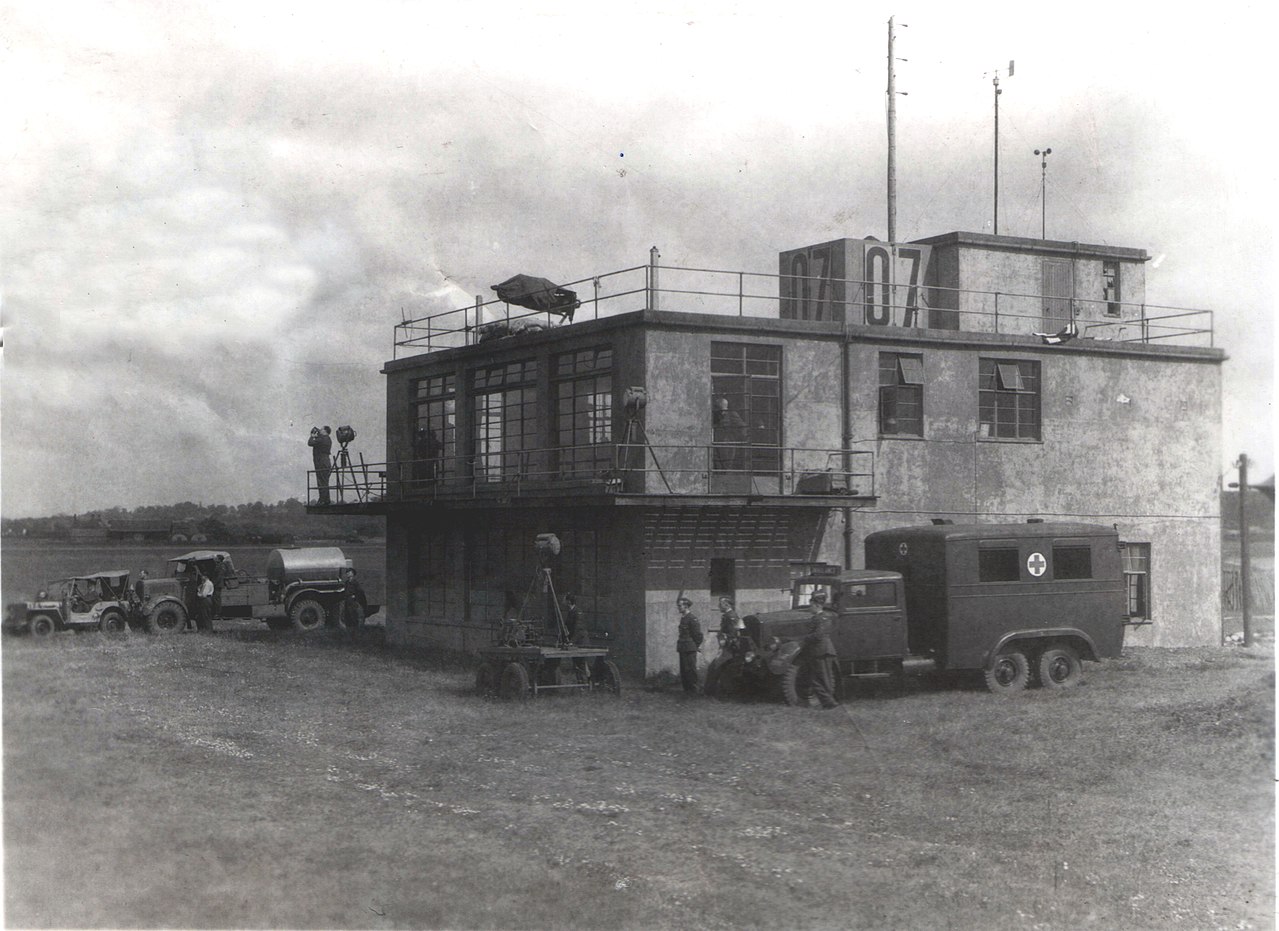

In a shallow Valley straddling the Hertfordshire/Bedfordshire County Border, RAF Tempsford was located largely in the Parish of Everton. Some 500-acres 4½-miles due South of St Neots & a mile from the A1 Trunk Road & Tempsford Village, was taken over in late-1940 for Airfield Construction. Built to Class-A Standard as a Satellite for Bassingbourn, the 3-Concrete Runways were O1-19 at 1,200-yds long, 07-25 at 1,580-yds & 13-31 at 1,333–yds. The usual 36-Pan Hard-standings were put down round the Perimeter Track. The Technical Site lay to the South between Runway Heads O1 & 31 and the Bomb Stores on the North side between Runway Heads 19 & 25 and close to Woodbury Lodge Farm & Woodbury Low Farm. To meet the expanding requirements of SOE, Tempsford was further developed. In 1942 Runways 01-19 & 07-25 were extended on their Northern ends to comprise overall lengths of 1,610 & 2,000-yds respectively. Perimeter Track Extensions were added to the ends of the Runway Extensions & the number of Pan Hard-standings raised to 50. Hangar building now involved 4–Type T2s on the Technical Site while a B1 was erected near Biggingwood Spinney, not far from the Everton Crossing Gates on the LNER Mainline, which paralleled the West side of the Airfield. The following year 2 more T2s were added on the East side of the Technical Site, South of Runway Head 31. Three Pan Standings were lost to this & other work, 3-Loop Standings being Constructed elsewhere on the Airfield as replacements. In addition to the large Hangars, Blister Types were put up on 4 of the Pan Standings to provide Shelter for Lysanders. The 7-Domestic, 2-Communal & Sick Quarters Site were dispersed in Fields mostly on the South side of the Tempsford-Everton Road, while the combined WAAF Communal & Domestic Area were Sited in Everton Village. Total Camp Accommodation was put at 1,722-male & 240-female.

The Buildings were mostly Brick Built & covered in Wood to give the impression that the Airfield was a Working Farm. The roof tiles of nearby Gibraltar Farm were removed & Cattle were allowed to Graze on the Airfield. Apparently, this fooled the German Reconnaissance into believing the Airfield was used for Agricultural Purposes. The Airfield was finally finished in the Spring of 1942 & handed over to Bomber Command. The recently established Special Duties Squadron, which was based at Newmarket, was offered the use of Tempsford. In March 1941, 419 Squadron, Based at Newmarket, became 1st 419 Flight & then 138 Squadron in August. On Valentines Day, February 14th, 161 Squadron was formed. April 8-10th 1942, No.161 Squadron (SD) move into the Airfield from Graveley, Commanded by Wing Commander E H Fielden, taking over Dispersal areas on the Western side of the Airfield.
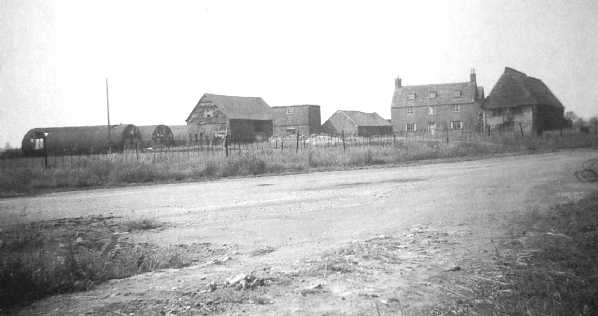
February 1943: The 1st Lockheed Hudsons are taken on charge for Pick-up Operations, giving an increased capacity over the Lysanders. The 1st Operation by Wing Commander Pickard to Charolles was on the 14th February 1943. The original plan for 138 Squadron was used by SOE & for the Military to use 161 Squadron. This idea was soon changed & 138 Squadron became responsible for Parachuting Duties whilst 161 Squadron had the responsibility Off-loading & Pick-up Duties. Although sharing the same Base, the 2-Units were separated, 138 Squadron being near to Gibralter Farm, 161 Squadron near to the Railway. Each Squadron had at their disposal 20-Halifaxes, along with a collection of 12-Lysanders & 2-Lockheed Hudsons. The main purpose of the Base was to Supply Resistance Fighters across Europe. Apart from Agent Drops & Pick-ups, the Resistance was supplied with anything it needed. As well as the things that we would expect a Resistance Fighter to need, Sten Guns, Revolvers, Ammunition, Explosives & Detonators, etc, such things like Cosmetics were also Supplied.


Metal Containers were used for dropping the supplies & they were made to look like Bombs. So good was the deception, some Workers at the Airfield believed that the Operations were for Bomber Command. Packages were also dropped at the same time as ‘Window‘, small metal strips to disrupt & confuse German Radar. Another diversion was the use of ‘Gingerbread Men‘ or “Ruperts“. These were 30″ tall Dummy Parachutists, formed in Hessian filled with Sand and said to look like “Pigmy Scarecrows” They were fitted with Barometric Detonators with a ‘Rifle-fire Simulator‘ attached. They were meant to confuse German Troops who thought they were being Outflanked.
A ‘Rupert‘ or ‘Gingerbread Man‘ was a Dummy Parachutist, designed to be dropped over Normandy as a decoy/distraction. It comprised a tan Hessian man-shaped Sack, designed to be filled with sand & thrown out of Aircraft, on which its integral Parachute would allow it to Float to the Ground & hopefully draw the attention of the Germans away from the Real Paras. Unlike the one in ‘The Longest Day‘ movie, this wasn’t like a Tailor’s Dummy in a Para Uniform; it was over 2ft tall when filled.
Between 1942 & 1945, it is reported that over 1,000 Agents were Flown from Tempsford along with 20,000-Containers & 10,000 Packages for the Resistance. They were approx. 5,500 Dropping Points in Europe with 5,600-Sorties made to France alone.
Flying Hudson & Halifax as
Flt/Lt A J L Craig
A Hudson had a minimum Crew of 3: Pilot, Navigator & Radio / Gunner; it could quite comfortably accommodate up to 10-Passengers. For a Hudson, the landing Speed was about 130-kph. For the Reception Area, it needed 5-Guidance Torches spread over 450M and the Landing Strip had to be at least 1,000Ms.

This Badge symbolises the role of the Squadron freeing Europe (open cuff). This was a highly Secretive Unit of the RAF, which, together with 138 Squadron, was tasked with Missions of the Special Operations Executive during the WW2. Their Primary role was to Drop & Collect Secret Agents & Equipment into & from Nazi-occupied Europe. The Squadron had a Secondary role in Acting as the King’s Flight. The Squadron was reformed at RAF Newmarket on 15th February 1942 when the King’s Flight was combined with Elements of 138 Squadron. In April, 161 Squadron moved to RAF Tempsford in Bedfordshire where it would remain until Disbandment on 2nd June 1945. It joined with No 138 in dropping Supplies & Agents over occupied Europe & took over the Landing & Pick-up Operations for which it used Lysanders, Havocs & Hudsons. Only a few Sorties were flown with the Havoc & many of these were as Convoy Escorts under the control of Fighter or Coastal Command. Halifax’s were received in November 1942 & in September 1944, it began using Stirlings with which it continued its Covert Tasks until the end of the War.
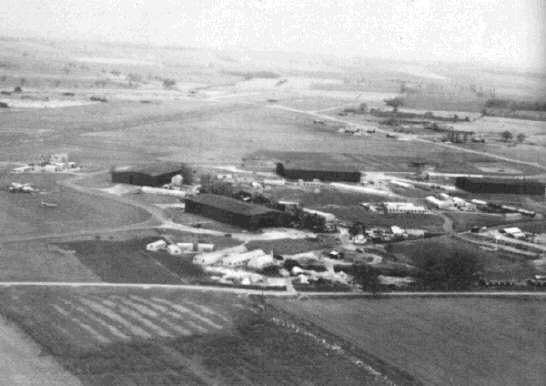

Robert Body is the nephew of F/Lt J W Menzies DFC and both F/Sgt Withers and F/Sgt Eliot were killed with him on 5/6 July 1944 on a Mission to drop Agents into Holland. Robert has written a new book out about Runways to Freedom, available in print or ebook format. The Nazi Occupation of much of Western Europe in early 1940 posed many challenges for the British Secret Services. A high priority was to find an effective means of Infiltrating & Exfiltrating Agents and, later, reliable methods for supplying the growing Resistance movements with Arms & Ammunition. The work fell outside the normal Duties of RAF Squadrons so, in March 1940, RAF Tempsford in Bedfordshire became the Base for No.138 (SD) Squadron & No.161 (SD) Squadrons. Flying mainly by the light of the full moon, these 2-Squadrons Operated throughout the length & breadth of Western Europe, delivering Agents & Supplies. Without the Agents the Secret Services would have been hamstrung & without the Supplies the Resistance Movements would have been unable to participate in the Armed Struggle. By the end of the War, the Squadrons had, between them, lost in excess of 600-men.
http://www.tempsford-squadrons.info/
http://www.161squadron.org/withersnewest.htm
Some of A J L-Craig’s Crew are Listed on this 2nd Site including:- F/Sgt Eric M Eliot Rear Gunner.
Whilst working at No.2 Technical School at RAF Karachi in the late-1930s, F/Sgt. Eliot took a keen interest in the state of European Politics & watched the Build-up of German Forces, ending with the Invasion of Poland. During the next few years, F/Sgt. Eliot Monitored the developments in Europe & increasingly, felt that he was not contributing enough to the War Effort. In 1942 he applied for a transfer back to England & also into Aircrew, where he thought he could be of more use. His application was accepted & on his return to England, he was sent on a Course to become an Air Gunner.
F/Sgt Withers –Wireless Operator & Gunner
Flight Sergeant Dennis Withers, like Flight Sergeant Elliot, joined 161 (Special Duties) Squadron from 31 Base and, from the records, it appears that he soon “Teamed up” with Flight Sergeant Eliot. Just 3-weeks before he was killed at age 22, Dennis was married to Joan. One of the Memories Joan recounts is that, on D-Day, she & Dennis were walking along a road to the Vicarage, to collect their Banns, when he remarked to her “you nearly didn’t have a husband last night; we landed back with a damaged Tail and a broken Wing. A tribute to the Pilot’s skill.” Unfortunately, whilst the record books show a Mission for that night, there was no Combat or Damage report.
http://harringtonmuseum.org.uk/HistoryTempsford.htm

July 1942 – Operation Ascension – Douglas Havocs commence flying Radio Intelligence Patrols at high level along the Channel Coast to relay Messages from SOE Agents using UHF (ultra high frequency) Transmitters.

Westland Lysander MKIII @ RAF Tangmere – A Tempsford Taxi with added Fuel Tank


Pilots of No. 161 (Special Duties) Squadron RAF standing in front of a Lysander ‘Jiminy Cricket‘ at RAF Tangmere, Sussex. They are (left to right): Flying Officer J A McCairns, Squadron Leader Hugh Verity, Group Captain Percy Charles “Pick” Pickard (Squadron Commander – & inset), Flight Lieutenant Peter Vaughan-Fowler & Flying Officer Frank “Bunny” Rymills. In front of Pickard sits his Old English Sheepdog Ming & to the right, Rymill’s Spaniel Henry. Note Verity’s Insignia below the Cockpit, around which are Stars, denoting the number of successful clandestine Missions to & from occupied France he had so far undertaken. F/O McCairns went on to complete 25-Sorties during his Tour of Duty.
Lysander Mark lll: By far the majority of the Special Operations Executive (SOE) Pick-up Operations conducted during WW2 from Tangmere by No.161 Specials Duties Squadron were undertaken by Westland Lysander Aircraft. The Lysander had originally been designed for Army Cooperation work. It was described by Pilots as “a beautiful little Plane to Fly and very manoeuvrable & ideal for getting in & out of small Landing Grounds”. For Special Duties work, Westland was awarded the Contract to modify Lysander Mk IIIs into dedicated ‘Special Duties’ Aircraft. The RAF designated MkIII (SD)s or MkIIIA (SD)s were modified by a Westland Subcontractor, Fairfield Aviation which had Works at Odham’s Press, Watford, Herts. About 40 SDs were produced, the Test Flying being carried out at nearby Elstree Aerodrome.
All Armament was removed and the normal Variable Pitch propeller was replaced by a constant speed 3-bladed version. A 150-gal permanently fixed, Fuel Tank was added under the Fuselage which increased the Aircraft’s range from 600-miles to about 1000 miles with an endurance of 10-hours fFlying. The normal Gunner’s compartment was modified considerably for the SD task. The Canopy was replaced with a one-piece unit that slid rearwards on rails to allow quick Entry & Exit. A Ladder was permanently fitted to the Port side to allow ease of Access & the Floor was Lengthened & Strengthened. The bulky Radio was replaced with a much smaller one & a rearward facing Bench for 2-Passengers was installed with a Locker underneath. A shelf was also Built at the rear of the compartment which could also serve as a Seat.
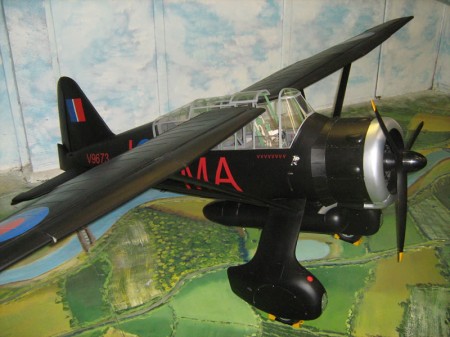
This Lysander Mk III Model was Constructed using photographs & original Plans found in a 1935 Book. The Model is scaled down to 4.2-Scale with a 12ft Wingspan & took nearly 5-yrs to complete in his spare time. It is fully Radio Controlled even down to all the Front leading edge Slats working. The Model is finished in the markings of V9673 (MA-J) ‘Jiminy Cricket’, Squadron Leader Hugh Verity’s Aircraft he Flew when at RAF Tangmere during 1943 as Commanding Officer of No.161 (SD) Squadron’s ‘A’ (Lysander) Flight.
Throughout the War, the Station was also a Secret Base for the Special Operations Executive who flew Agents in & out of occupied France to strengthen the Resistance. The SOE used Tangmere Cottage, opposite the Main Entrance to the Base. Today the Cottage sports a Commemorative Plaque to its former Secret Life. Pickard had a slightly different definition of “Rest” than other Pilots. His next Tour was possibly the most dangerous of all, Commanding 161 Squadron. Their role was Ferrying Spies & Saboteurs for the SOE (Special Operations Executive) into & out of occupied France. This aspect of RAF work had grown to the point that it was centralised at RAF Tempsford in Bedfordshire, which became the RAF’s most Secret Base. The modus operandi was usually the same. SOE Agents were lodged in a Local Hotel before being Ferried to Farm Buildings that had unusually been left standing within the Perimeter TYrack of the Airfield. This was the famous “Gibraltar Farm”. After final Briefings & Checks at the Farm, the Agents were issued Firearms in the Barn & then boarded onto an awaiting Aircraft then flown by one of a Team of Pilots that included Pickard. If a Parachute drop was not deemed suitable, the Aircraft would be required to Land in darkness in a French Field, where they would be met by French Resistance. Where the landing Signal was sent, the small Lysander or Hudson Aircraft would have just 3-torch lights to guide the Pilot into a rough field, one at each end of the Strip, and one to indicate its Width. Having landed, Pickard & his colleagues would not know whether it would be the French Resistance greeting him, or the Gestapo. This would often not be a smooth Operation. On one occasion he was not met by the expected Signal from the Ground & circled the Site for almost 2-hrs, using up most of his fuel & only just making it home. On another occasion, his unarmed Aeroplane was caught by 2-German Fighters whilst still over France. His slow speed was his one advantage & by skilfully timing his turns he Forced the Fighters to Overshoot without landing effective Shots. They Attacked time and time again right across the Channel before they Fled from the British Fighters scrambled to Escort him home.
9th February 1944 – Ascension Operation, Hudson lll N (2.50) Logged as Ops
Crew: Fl/Lt. Craig, Fl/Sgt Klaus, Sgt. Withers, Sgt Eliot, F/O Hall – “Bullet” Successful
11 February 1944 – Ascension Operation, Hudson lll N (2.00) Logged as Ops
Crew: Fl/Lt. Craig, F/O Hall. F/Sgt Klaus, F/Sgt Withers, F/Sgt Eliot, “Bullet” Successful
20th February 1944 – Ascension Operation, Hudson lll N (1.30) Logged as Ops
Crew: Fl/Lt. Craig, F/O Hall. F/Sgt Withers, F/Sgt Eliot, F/Sgt Arthur “Speed” & “Nylon” – Unsuccessful
23rd February 1944 — Ascension Operation, Hudson lll N (1.45) Logged as Ops
Crew: Fl/Lt Craig, F/O Hall. F/Sgt Klaus, F/Sgt. Withers, F/Sgt Eliot, “Player & Bullet” Interference too bad for communication with “Player”. “Bullet” contacted but nothing to pass.
Ascension Ops – All Covert –
UHF Radio Contact with Agents – viz. Arnold, Nylon, Bullet, Speed & Player
Essentially Flying up and down the English Channel in order to make UHF signals contact with Secret Agents.
The Secret Intelligence Service (SIS) – now known as MI6 viewed SOE with great Suspicion. Head of the SIS, Sir Stewart Menzies, stated repeatedly that SOE were ‘Amateur, Dangerous, & Bogus‘ & took it upon himself to bring massive internal pressure to bear on the Fledgeling Organisation. SIS did not want SOE disrupting their Agent’s Intelligence-gathering Operations by blowing up Bridges & Factories. Bomber Command also despised SOE & resented having to loan Aircraft for ‘unethical’ clandestine Missions. They like Harris wanted to win the War by Bombing Germany to its knees.
At 1st, SOE’s Radio Traffic went through the SIS-controlled Radio Station at Bletchley Park. From 1 June 1942 SOE used its own Transmitting & Receiving Stations at Grendon Underwood & Poundon, both in Bucks (and near Bletchley Park; the Location & Topography were suitable for all 3-Sites). Teleprinters linked the Radio Stations with SOE’s HQ in Baker Street. The most significant failure of the Service during the War was known as the Venlo Incident, named for the Dutch Town where much of the Operation took place. Agents of the German Army Secret Service, the Abwehr & the Counter-Espionage Section of the Sicherheitsdienst (SD), posed as high-Ranking Officers involved in a Plot to depose Hitler. In a series of meetings between British Secret Intelligence Service Agents & the ‘Conspirators’, SS plans to abduct the SIS Team were shelved due to the presence of Dutch Police. On the Night of 8/9th November 1939, a meeting took place without Police presence. There, the 2–SIS Agents Best & Stevens were duly Abducted by the SS
25th February 1944 – Air/Sea Rescue Patrol (3.20)
1st March 1944 – Ascension Operation, Hudson – Up 11.20 Down 13.40
Crew: Fl/Lt Craig, F/O Thornton, F/S Withers, F/S Eliot, F/S Arthur. “Bullet” – Short contact was made during which a short unimportant message was indicated. Contact lost before the message could be passed.
3rd March 1944 – Ops France (6.09) Halifax U – Possible drop
6th March 1944 – Footman 19 Operation France 20.15-03.55 (7.55) Hudson P
Crew: Fl/Lt Craig, F/O Hall. F/Sgt Withers, F/Sgt Eliot. Failed to pinpoint drop Zone – dropped leaflets Landed RAF Tangmere Nr Chichester, West Sussex 03.55
Pilot F/Lt J W Menzies DFC & both F/Sgt Withers & F/Sgt Eliot were killed on 5/6th July 1944 during a Mission to Drop Agents into Holland.
